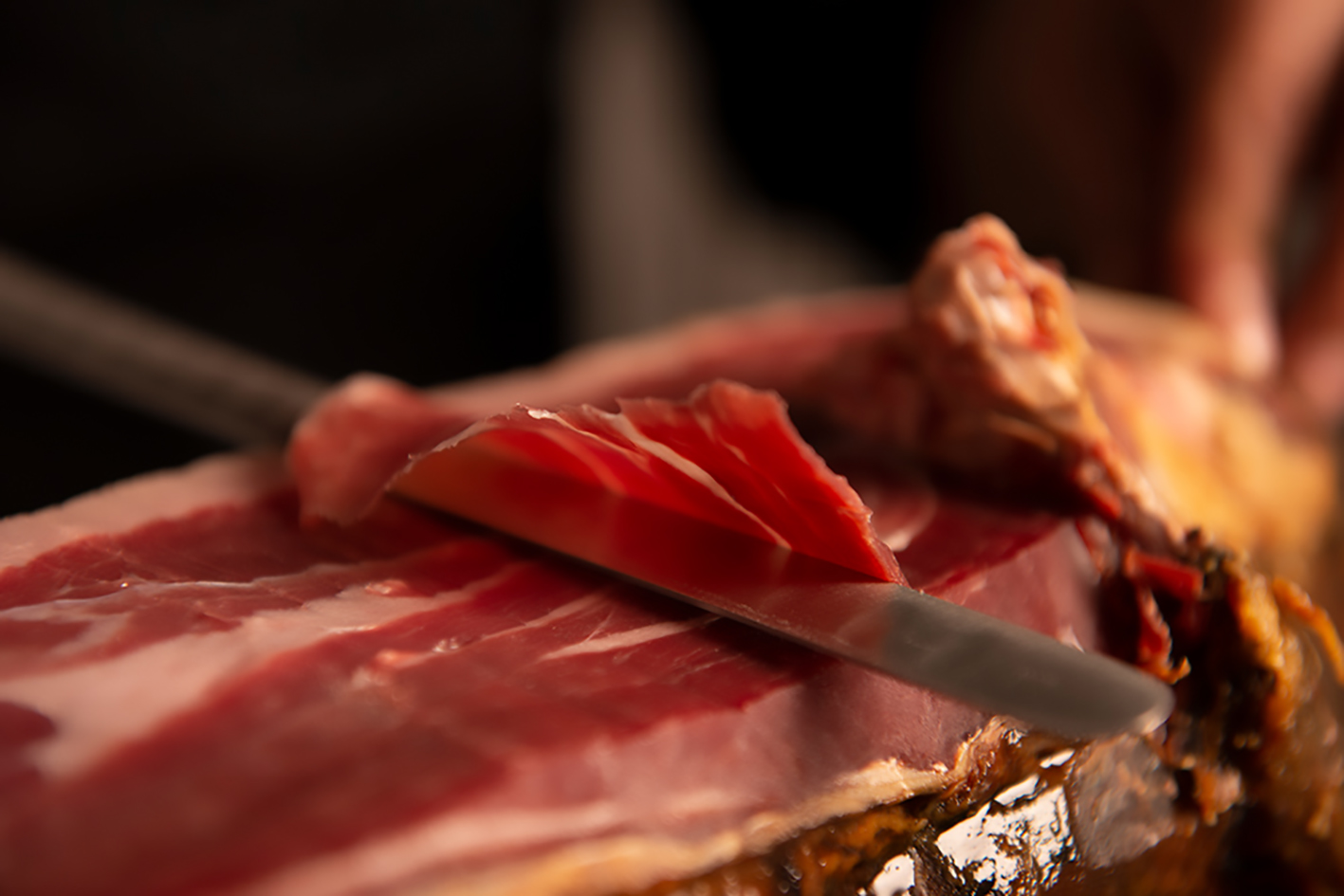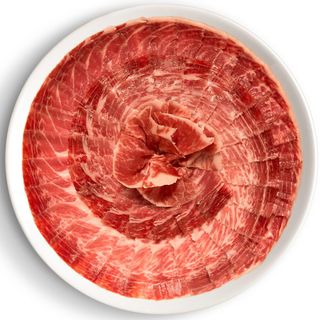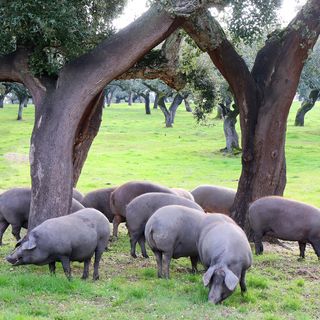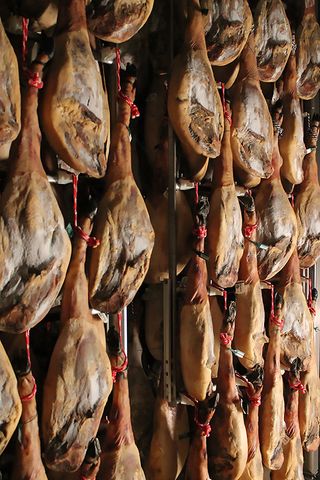Curious Questions: Do delicious hams from little acorns grow?
Jamón Iberico is undeniably delicious – and undeniably pricey. Martin Fone took a trip to Spain to find out how it gets that way.


I am in a field outside Jerez de los Caballeros in the south-western province of Badejoz in Spain. The countryside, known as the ‘Dehesa’, consists of verdant pastureland interspersed with evergreen oaks, principally holm and cork. I’m here to see a slightly startled shroud of swine, going about their daily business.
Once they have got used to my presence, they get back to hoovering up as many acorns as they can from among the thousands that have fallen from the oaks. During the montanera – the fattening season, running from the beginning of October to the end of March – the pigs roam free, each of them eating up to 22lbs of acorns a day. That’s a couple of thousand acorns per pig.
For many Spanish, jamón Ibérico is something to be rolled out and consumed on high days, holidays and weddings and pata negra, named after the distinctive black trotters of pure Iberian pigs, is the bee’s knees. I’m here to find out what all the fuss is about. And, frankly, why it is so expensive.
In a nutshell (or, rather, an acorn shell) it’s all about genetics, feeding and the curing process.

To be classed as an Iberian pig for commercial purposes, the mother must be from 100% pure Iberian stock. The father can either be 100% Iberian, 50% Iberian or from Duroc pig stock. Only those pigs with 100% Iberian genes from both parents can qualify for the highly prized black label, but even then it is not a given.
The next hurdle to be jumped, a difficult feat for these portly porkers, is the feeding process. After being fed on a diet of cereals (principally barley) and acorns until they tip the scales at of 100kg, a milestone that’s ideally timed to coincide with the montanera season. They then need to spend at least 61 days in the Dehesa, devouring the bountiful supply of acorns, herbs and grass. To qualify for the black label, the pig must have put on at least 46 kilos out in the open; its carcass, after evisceration, must weigh a minimum of 108 kilos.

After slaughter, quartering and trimming, the legs, fore and aft, are enveloped in containers full of sea salt for a couple of weeks to draw out water and to assist the preservation process. After rinsing and a three-month resting period, the ham is then cured and aged in either a cellar or a natural dryer in an environment where temperature and humidity is carefully controlled. The whole process can take three years or more – at this point you’d be forgiven for feeling that it’s more like making whisky than curing meat.
Sign up for the Country Life Newsletter
Exquisite houses, the beauty of Nature, and how to get the most from your life, straight to your inbox.
Judging when the ham is ready to be released to the commercial market takes years of practice. Using a thin, sharp instrument called a cala, made from the tibia bone of a cow or a horse, the taster makes a couple of test holes in the flesh to satisfy themselves that the intensity of taste and aromas are up to scratch.
The Interprofessional Association of the Iberian Pig (ASICI) are, rightly, proud of the rigorous standards that have been imposed on their product, following the 2014 Royal Decree. They claim buy-in from 90% of the farmers and 100% of the production units. There is even an app available – isn’t there always? – that enables the user to obtain all the information about the provenance of any piece of ham you could possibly need, simply from pointing their phone at the tag.
The upshot of all this is that it’s nigh-on impossible for supply to be adjusted easily to meet any increase in demand. Thus, simple economics operate: the price becomes volatile and, as word of the ham reaches a wider international audience, it can only increase. Again, the whisky analogy springs to mind.

Jamón Ibérico also comes with red or green or white labels. Red labels indicate acorn-fed pigs that are either 75% or 50% Iberian, green labels indicate pigs which are at least 50% pure and free-range, fed on a non-acorn diet, whilst white label hams are from at least 50% pure stock, kept on farms and fed on commercial fodder.
Of course, the thousand-euro question is this: what does pata negra taste like?
It has a very distinctive, nutty, strong flavour with a pleasantly tingling and long-lingering aftertaste. I also found the green label ham to be very moreish, with a less intensive taste and a higher fat content. Though if you are worried about the high fat content, you shouldn’t be. Ham from acorn-fed pigs has a high oleic oil content – only virgin olive oil has more – and medical research has shown that this promotes good and suppresses bad cholesterol. What’s not to like?
As to whether it is worth the money, as the Spanish might say, cada uno a su gusto. But, at least from my perspective, the answer to this curious question is a very definite yes.

Credit: Rex
Curious Questions: Why do we still use the QWERTY keyboard?
The strange layout of keyboards in the Anglophone world is as bafflingly illogical. Martin Fone, author of 'Fifty Curious Questions',

Credit: apples and oranges Photo by Best Shot Factory/REX/Shutterstock
Curious Questions: Can you actually compare apples and oranges?
It's repeated so often these days that we've come to regard it as a truism, but are apples and oranges

Curious Questions: Do you get wetter running or walking in the rain?
Does running in the rain get you out of it quicker? Or do you just run into more water more

Curious Questions: Why is the Green Room called the Green Room?
Whether you're performing a play or about to go on television, the waiting room is called the Green Room – but

Credit: Rex
Curious Questions: How do you take a group photo in which nobody is blinking?
-
 Game, set, match: 12 of the world’s most beautiful tennis courts
Game, set, match: 12 of the world’s most beautiful tennis courtsFrom Italy to Indonesia, when it comes to hotel amenities, a picturesque tennis court will always trump a 24-hour gym. So, before you book your next holiday, take a look at our pick of the 12 best.
By Rosie Paterson Published
-
 Five frankly enormous mansions, including one with its own private swimming lake, as seen in Country Life
Five frankly enormous mansions, including one with its own private swimming lake, as seen in Country LifeSometimes bigger really is better.
By Toby Keel Published
-
 Curious questions: Why do we use Seville oranges to make marmalade?
Curious questions: Why do we use Seville oranges to make marmalade?Why do we use Seville oranges to make marmalade when there are more than 400 other varieties available worldwide? And do they really make the best preserve? Jane Wheatley investigates.
By Jane Wheatley Published
-
 Mince pies really did once contain meat — and this Victorian recipe will convince you that they should to this day
Mince pies really did once contain meat — and this Victorian recipe will convince you that they should to this dayOnce packed with meat, such as ox tongue and mutton, alongside dried and candied fruit and extravagant spices, the mince pie is not what it once was — and food historian Neil Buttery says that's made them worse.
By Neil Buttery Published
-
 Curious Questions: Margarine used to be pink — but why?
Curious Questions: Margarine used to be pink — but why?Margarine has been a staple of our breakfast tables for over a century, but it hasn't always had a smooth ride — particularly from the dairy industry, who managed to impose a most bizarre sanction on their easily-spreadable, industrially mass-produced rival. Martin Fone explains.
By Martin Fone Published
-
 Curious Questions: Wine has been made in Britain for over 1,000 years — so why have we only just turned it into an industry?
Curious Questions: Wine has been made in Britain for over 1,000 years — so why have we only just turned it into an industry?With the UK wine industry booming, Martin Fone takes a look at its history.
By Martin Fone Published
-
 Curious Questions: What is mock turtle soup? And did it come before or after 'Alice in Wonderland'?
Curious Questions: What is mock turtle soup? And did it come before or after 'Alice in Wonderland'?Martin Fone delves into the curious tale of an iconic Victorian delicacy: mock turtle soup.
By Martin Fone Published
-
 A game of two halves — how the sandwich went from humble fare to a country-wide lunchtime obsession
A game of two halves — how the sandwich went from humble fare to a country-wide lunchtime obsessionWhat started life as a way to eat and play cards at the same time (so the story goes) is now the lunch of choice for the working world.
By Emma Hughes Published
-
 Where to find the world's best club sandwich — and the story of this triple-layered paean to poolside delight
Where to find the world's best club sandwich — and the story of this triple-layered paean to poolside delightThe club sandwich, arguably the most famous of all sarnies, is a poolside staple, but its origins are tricky to trace, says Tom Parker Bowles.
By Tom Parker-Bowles Published
-
 Curious Questions: Why do we eat hot cross buns at Easter?
Curious Questions: Why do we eat hot cross buns at Easter?Annunciata Elwes traces the curious history of the hot cross bun in Britain.
By Annunciata Elwes Published